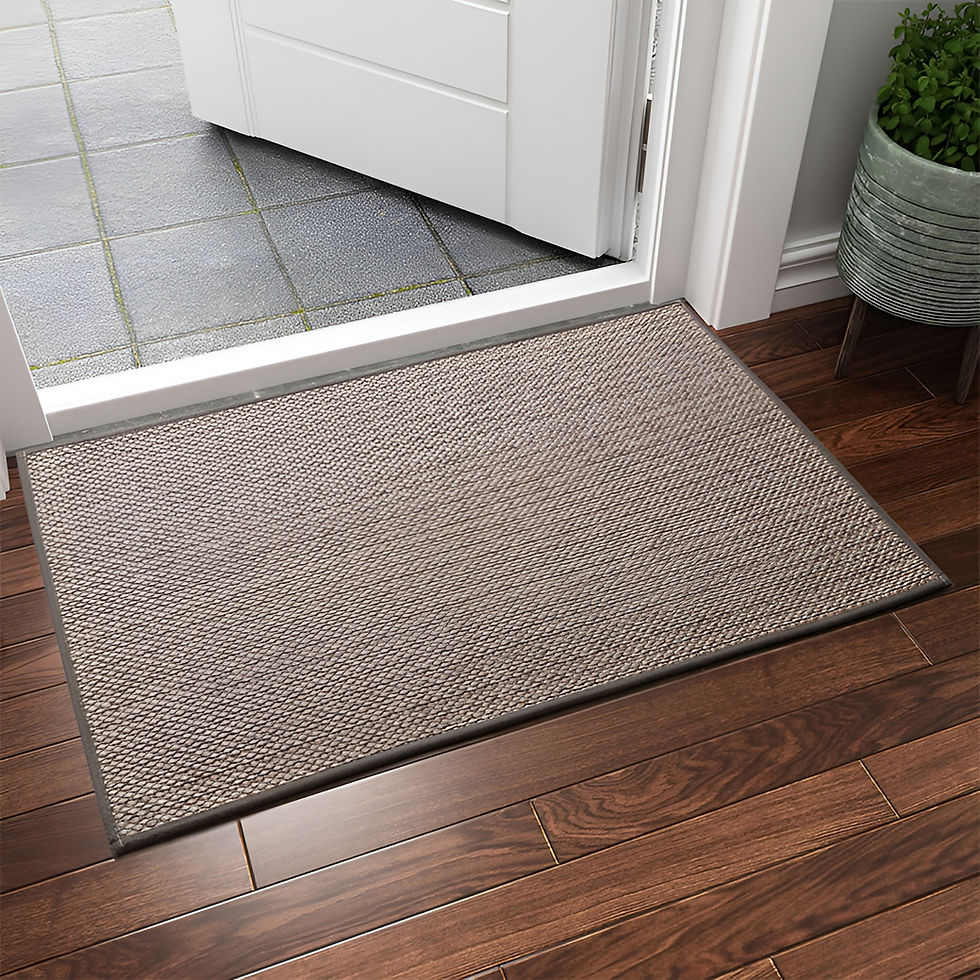The Best Washable Indoor Mats for your Home
- Floor Safety Store

- Dec 18, 2023
- 4 min read
Doormats, that offer non-slip, absorbing floor protection from spills and muddy footprints, are among the best interior Indoor Door Mats. These inner door mats are washable in the dishwasher and tumble dryer safe. Super-absorbent cotton tufts used in the construction of mats work hard to trap dirt and moisture in your kitchen, bathroom, and indoor front door. They shield your flooring from mud, filth, and dust, keeping your house cleaner for longer. Stylish door mats come in a range of patterns and hues to compliment the interior decor of any house. Ideal for use as a welcome mat or entryway in your kitchen, living room, bathroom, utility room, or anyplace else it can soak up.
Using an indoor doormat prevents muddy footprints from spreading when you clean your feet and remove your shoes after shoveling snow or walking home from the workplace in the slush. They also make it easier to wipe your pet's paws during a winter stroll. Your doorway greets guests as soon as they arrive at your house, you should stock it with things that bring you joy. Best indoor doormats to place in your entryway so that your feet stay dry and the floor stays free of muck.
The Purpose of Using Mats
Better than flooring alone, high-quality mats endure wear and tear from frequent foot activity. Because indoor door mats are water-absorbent and can safely remove any mess, they are a practical answer to keeping your house clean and organized. Slippery flooring can be caused by moisture, filth, or dust. Indoor matting offers safe, non-slip traction. They are simple to bring in outside muck, snow, and rain. Indoor mats collect this dust, keeping floors cleaner. In areas where you stand a lot, such as kitchens and bathrooms, cushioned mats provide a softer feel underfoot. Germs and bacteria can enter through shoes. Mats for indoor use help block pollutants at the entryway. You may add visual appeal, color, and texture with decorative mats. With so many styles to choose from, you may also choose a mat that complements your interior décor, making it a useful yet fashionable addition to your house. Here are some types of mats that are used in homes to provide your house an elegant appearance.

Mats to Reduce Fatigue
Anti-fatigue Washable Indoor Door Mats are made to be comfortable and to reduce physical strain, especially in places where people spend a lot of time standing. The cushioning qualities of these mats lessen strain and discomfort on the back, legs, and feet. They are frequently seen in factories, workshops, and industrial kitchens.
Mats at the Entrance
At the front of a building or space, entry mats also referred to as doormats or welcome mats are put. Entrance mats may be personalized with logos or patterns and are available in a variety of materials, including rubber, nylon, and coir. Their primary purpose is to catch dirt, debris, and moisture to prevent shoes from being tracked inside.
Mats For the Kitchen
The purpose of these mats is to make the kitchen floor a cozy and non-slip walking area. For increased safety and to lessen strain, they are frequently composed of rubber or vinyl and may have a cushioned or textured surface.
Outdoor Mats:
Made of resilient materials that don't fade, mold, or mildew, such as rubber or polypropylene, outdoor mats are meant to last. Sunlight, rain, and snow are just a few of the weather conditions that outdoor mats are made to resist. Usually, they are placed in front of patios, pools, and entrances.
Matting for Bathrooms:
They are made of cotton or microfiber and feature a non-slip backing. In damp spaces like shower rooms and bathrooms, bathroom mats are used to absorb water and stop slippage.
Stair Mats
These matting are designed to provide more grip and cushioning on stairs to reduce the risk of slips and falls. They might be made of rubber or vinyl, and their surface could be patterned or textured.
How to Pick the Ideal Mat For Your House?
Using an indoor entrance mat can help lower the chance of dirt and debris tracking as well as falls and slips. By acting as a barrier between your building and the outside environment, they can also assist in extending the life of your flooring.
Select the right size by taking measurements of the area and, if feasible, adding additional length to allow for numerous stages. Choose materials that are appropriate for the traffic type: cushioned mats for standing areas, heavy-duty mats for high-traffic zones, etc. Make sure the edges of the mats are beveled to prevent tripping risks. Based on the material, structure, and positioning, consider cleaning convenience. Whether the mat's purpose is to collect dirt, absorb moisture, give comfort, or serve as décor, match it to the job. Select backings that are appropriate for the type of floor, such as wood, vinyl, tile, or carpet. Budgeting is important because costs vary greatly depending on the material and structure. To meet your demands, indoor door mats come in a range of sizes, colors, and textures. Select an easy-to-clean washable indoor mat or one that is absorbent to absorb more water.





Comments